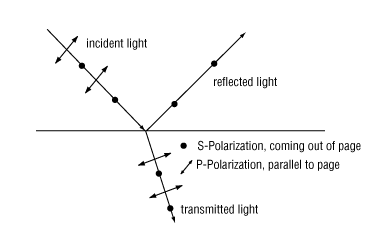
S&P polarization refers to the plane in which the electric field of a light wave is oscillating. S-Polarization is the plane of polarization perpendicular to the page (coming out of the monitor screen). P-polarization is the plane of polarization parallel to the page (in the plane of the monitor screen). See figure below:

When referring to polarization states, the p-polarization refers to the polarization plane parallel to the polarization axis of the polarizer being used ("p" is for "parallel"). The s-polarization refers to the polarization plane perpendicular to the polarization axis of the polarizer. A linear polarizer, by design, polarizes light in the p-polarization.
You offer a number of polarizers and retarders in both glass and film formats. Which one would be best for me?
The choice of polarizer substrate generally comes down to the optical needs of the system (i.e. weight and budget). In general, the glass filters tend to have higher quality polarizing characteristics. When surface accuracy is a concern (for instance in imaging applications), glass polarizers are preferable.
It is important to mount the polarizing filter, or any other filter, after the lens. Mounting the polarizer between the lens and the camera causes a change in the path difference between the sensor and the lens, and results in the image not being focused properly at the camera sensor plane. This effect holds true for all filters, such as ND filters, IR filters, etc. Our video lens specifications list the size of each lens' filter threading. Simply match the filter thread of the lens to the filter thread of our pre-mounted linear glass polarizing filters. The mounted filters have identical threads, so two can be used together to create a variable density effect.
or view regional numbers
QUOTE TOOL
enter stock numbers to begin
Copyright 2023 | Edmund Optics, Ltd Unit 1, Opus Avenue, Nether Poppleton, York, YO26 6BL, UK
California Consumer Privacy Acts (CCPA): Do Not Sell or Share My Personal Information
California Transparency in Supply Chains Act